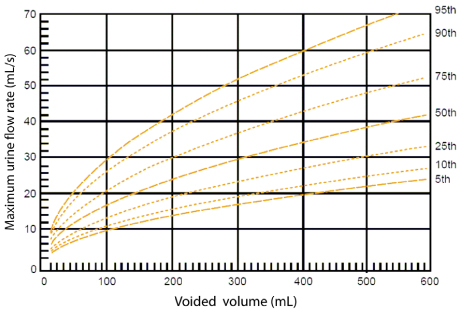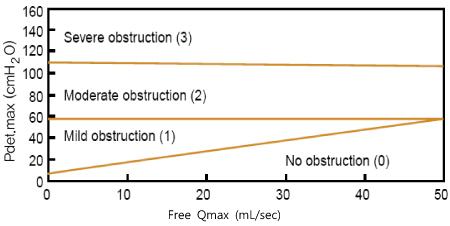Korean J Obstet Gynecol.
2010 Sep;53(9):761-768. 10.5468/kjog.2010.53.9.761.
Management of voiding dysfunction after anti-incontinence operation
- Affiliations
-
- 1Department of Obstetric and Gynecology, Gachon University of Medicine and Science, Incheon, Korea. kchob@gilhospital.com
- KMID: 2077993
- DOI: http://doi.org/10.5468/kjog.2010.53.9.761
Abstract
- With the increasing number of surgery for incontinence, voiding dysfunction after anti-incontinence surgery will continue to be a problem. The patient with postoperative voiding dysfunction may present with primarily storage symptoms or voiding symptoms, or a combination of both. Detailed knowledge of the preoperative voiding status may aid in the diagnosis of voiding dysfunction. Diagnosis is based on history, physical examination, urinalysis and postvoid residual volume, but additional informations from urodynamic study and cystoscopy are useful. Patients with postoperative voiding dysfunction should be initially treated conservatively with intermittent or continuous catheterization, fluid restriction, anticholinergics and pelvic floor physiotherapy. When conservative treatment fails, surgical intervention should be done. It is important to distinguish between midurethral sling and other procedures because the timing and type of intervention vary. In case of midurethral sling, loosening or cutting the tape has had excellent results. Prevention of obstruction during surgery may be the best way to avoid reoperation.
MeSH Terms
Figure
Reference
-
1. Ulmsten U, Henriksson L, Johnson P, Varhos G. An ambulatory surgical procedure under local anesthesia for treatment of female urinary incontinence. Int Urogynecol J Pelvic Floor Dysfunct. 1996. 7:81–85.2. de Leval J. Novel surgical technique for the treatment of female stress urinary incontinence: transobturator vaginal tape inside-out. Eur Urol. 2003. 44:724–730.3. Nilsson CG, Palva K, Rezapour M, Falconer C. Eleven years prospective follow-up of the tension-free vaginal tape procedure for treatment of stress urinary incontinence. Int Urogynecol J Pelvic Floor Dysfunct. 2008. 19:1043–1047.4. Agostini A, Bretelle F, Franchi F, Roger V, Cravello L, Blanc B. Immediate complications of tension-free vaginal tape (TVT): results of a French survey. Eur J Obstet Gynecol Reprod Biol. 2006. 124:237–239.5. Tamussino KF, Hanzal E, Kolle D, Ralph G, Riss PA. Tension-free vaginal tape operation: results of the Austrian registry. Obstet Gynecol. 2001. 98:732–736.6. deTayrac R, Deffieux X, Droupy S, Chauveaud-Lambling A, Calvanese-Benamour L, Fernandez H. A prospective randomized trial comparing tension-free vaginal tape and transobturator suburethral tape for surgical treatment of stress urinary incontinence. Am J Obstet Gynecol. 2004. 190:602–608.7. Porena M, Costantini E, Frea B, Giannantoni A, Ranzoni S, Mearini L, et al. Tension-free vaginal tape versus transobturator tape as surgery for stress urinary incontinence: results of a multicentre randomised trial. Eur Urol. 2007. 52:1481–1490.8. Gomelsky A, Nitti VW, Dmochowski RR. Management of obstructive voiding dysfunction after incontinence surgery: lessons learned. Urology. 2003. 62:391–399.9. Carr LK, Webster GD. Voiding dysfunction following incontinence surgery: diagnosis and treatment with retropubic or vaginal urethrolysis. J Urol. 1997. 157:821–823.10. Blaivas JG, Groutz A. Bladder outlet obstruction nomogram for women with lower urinary tract symptomatology. Neurourol Urodyn. 2000. 19:553–564.11. Haylen BT, Law MG, Frazer M, Schulz S. Urine flow rates and residual urine volumes in urogynecology patients. Int Urogynecol J Pelvic Floor Dysfunct. 1999. 10:378–383.12. Costantini E, Mearini E, Pajoncini C, Biscotto S, Bini V, Porena M. Uroflowmetry in female voiding disturbances. Neurourol Urodyn. 2003. 22:569–573.13. Leach GE, Dmochowski RR, Appell RA, Blaivas JG, Hadley HR, Luber KM, et al. Female Stress Urinary Incontinence Clinical Guidelines Panel summary report on surgical management of female stress urinary incontinence. The American Urological Association. J Urol. 1997. 158:875–880.14. Dunn JS Jr, Bent AE, Ellerkman RM, Nihira MA, Melick CF. Voiding dysfunction after surgery for stress incontinence: literature review and survey results. Int Urogynecol J Pelvic Floor Dysfunct. 2004. 15:25–31.15. Abouassaly R, Steinberg JR, Lemieux M, Marois C, Gilchrist LI, Bourque JL, et al. Complications of tension-free vaginal tape surgery: a multi-institutional review. BJU Int. 2004. 94:110–113.16. Deval B, Jeffry L, Al Najjar F, Soriano D, Darai E. Determinants of patient dissatisfaction after a tension-free vaginal tape procedure for urinary incontinence. J Urol. 2002. 167:2093–2097.17. Haab F, Sananes S, Amarenco G, Ciofu C, Uzan S, Gattegno B, et al. Results of the tension-free vaginal tape procedure for the treatment of type II stress urinary incontinence at a minimum followup of 1 year. J Urol. 2001. 165:159–162.18. Jeffry L, Deval B, Birsan A, Soriano D, Darai E. Objective and subjective cure rates after tension-free vaginal tape for treatment of urinary incontinence. Urology. 2001. 58:702–706.19. Karram MM, Segal JL, Vassallo BJ, Kleeman SD. Complications and untoward effects of the tension-free vaginal tape procedure. Obstet Gynecol. 2003. 101:929–932.20. Kuuva N, Nilsson CG. A nationwide analysis of complications associated with the tension-free vaginal tape (TVT) procedure. Acta Obstet Gynecol Scand. 2002. 81:72–77.21. Levin I, Groutz A, Gold R, Pauzner D, Lessing JB, Gordon D. Surgical complications and medium-term outcome results of tension-free vaginal tape: a prospective study of 313 consecutive patients. Neurourol Urodyn. 2004. 23:7–9.22. Nilsson CG, Kuuva N, Falconer C, Rezapour M, Ulmsten U. Long-term results of the tension-free vaginal tape (TVT) procedure for surgical treatment of female stress urinary incontinence. Int Urogynecol J Pelvic Floor Dysfunct. 2001. 12:Suppl 2. S5–S8.23. Rezapour M, Ulmsten U. Tension-Free vaginal tape (TVT) in women with mixed urinary incontinence--a long-term follow-up. Int Urogynecol J Pelvic Floor Dysfunct. 2001. 12:Suppl 2. S15–S18.24. Andonian S, Chen T, St-Denis B, Corcos J. Randomized clinical trial comparing suprapubic arch sling (SPARC) and tension-free vaginal tape (TVT): one-year results. Eur Urol. 2005. 47:537–541.25. Deval B, Levardon M, Samain E, Rafii A, Cortesse A, Amarenco G, et al. A French multicenter clinical trial of SPARC for stress urinary incontinence. Eur Urol. 2003. 44:254–258.26. Gandhi S, Abramov Y, Kwon C, Beaumont JL, Botros S, Sand PK, et al. TVT versus SPARC: comparison of outcomes for two midurethral tape procedures. Int Urogynecol J Pelvic Floor Dysfunct. 2006. 17:125–130.27. Hodroff MA, Sutherland SE, Kesha JB, Siegel SW. Treatment of stress incontinence with the SPARC sling: intraoperative and early complications of 445 patients. Urology. 2005. 66:760–762.28. Costa P, Grise P, Droupy S, Monneins F, Assenmacher C, Ballanger P, et al. Surgical treatment of female stress urinary incontinence with a trans-obturatortape (T.O.T.) Uratape: short term results of a prospective multicentric study. Eur Urol. 2004. 46:102–106.29. Davila GW, Johnson JD, Serels S. Multicenter experience with the Monarc transobturator sling system to treat stress urinary incontinence. Int Urogynecol J Pelvic Floor Dysfunct. 2006. 17:460–465.30. Delorme E, Droupy S, de Tayrac R, Delmas V. Transobturator tape (Uratape): a new minimally-invasive procedure to treat female urinary incontinence. Eur Urol. 2004. 45:203–207.31. Deval B, Ferchaux J, Berry R, Gambino S, Ciofu C, Rafii A, et al. Objective and subjective cure rates after trans-obturator tape (OBTAPE) treatment of female urinary incontinence. Eur Urol. 2006. 49:373–377.32. Spinosa JP, Dubuis PY. Suburethral sling inserted by the transobturator route in the treatment of female stress urinary incontinence: preliminary results in 117 cases. Eur J Obstet Gynecol Reprod Biol. 2005. 123:212–217.33. Lukacz ES, Luber KM, Nager CW. The effects of the tension-free vaginal tape on voiding function: a prospective evaluation. Int Urogynecol J Pelvic Floor Dysfunct. 2004. 15:32–38.34. Barry C, Naidu A, Lim Y, Corsitaans A, Muller R, Rane A. Does the MONARC transobturator suburethral sling cause post-operative voiding dysfunction? A prospective study. Int Urogynecol J Pelvic Floor Dysfunct. 2006. 17:30–34.35. Schafer W, Abrams P, Liao L, Mattiasson A, Pesce F, Spangberg A, et al. Good urodynamic practices: uroflowmetry, filling cystometry, and pressure-flow studies. Neurourol Urodyn. 2002. 21:261–274.36. Chassagne S, Bernier PA, Haab F, Roehrborn CG, Reisch JS, Zimmern PE. Proposed cutoff values to define bladder outlet obstruction in women. Urology. 1998. 51:408–411.37. Lemack GE, Zimmern PE. Pressure flow analysis may aid in identifying women with outflow obstruction. J Urol. 2000. 163:1823–1828.38. Defreitas GA, Zimmern PE, Lemack GE, Shariat SF. Refining diagnosis of anatomic female bladder outlet obstruction: comparison of pressure-flow study parameters in clinically obstructed women with those of normal controls. Urology. 2004. 64:675–679.39. Mishra VC, Mishra N, Karim OM, Motiwala HG. Voiding dysfunction after tension-free vaginal tape: a conservative approach is often successful. Int Urogynecol J Pelvic Floor Dysfunct. 2005. 16:210–214.40. Ghoniem G, Abdelwahab H, Elmissiry M, Khater U. Surgical choices for the treatment of bladder outlet obstruction after sling procedures. J Pelvic Med Surg. 2008. 14:369–374.41. Zimmern PE, Hadley HR, Leach GE, Raz S. Female urethral obstruction after Marshall-Marchetti-Krantz operation. J Urol. 1987. 138:517–520.42. Foster HE, McGuire EJ. Management of urethral obstruction with transvaginal urethrolysis. J Urol. 1993. 150:1448–1451.43. Nitti VW, Raz S. Obstruction following anti-incontinence procedures: diagnosis and treatment with transvaginal urethrolysis. J Urol. 1994. 152:93–98.44. Cross CA, Cespedes RD, English SF, McGuire EJ. Transvaginal urethrolysis for urethral obstruction after anti-incontinence surgery. J Urol. 1998. 159:1199–1201.45. Goldman HB, Rackley RR, Appell RA. The efficacy of urethrolysis without re-suspension for iatrogenic urethral obstruction. J Urol. 1999. 161:196–198.46. Carey JM, Chon JK, Leach GE. Urethrolysis with Martius labial fat pad graft for iatrogenic bladder outlet obstruction. Urology. 2003. 61:21–25.47. Petrou SP, Brown JA, Blaivas JG. Suprameatal transvaginal urethrolysis. J Urol. 1999. 161:1268–1271.48. Webster GD, Kreder KJ. Voiding dysfunction following cystourethropexy: its evaluation and management. J Urol. 1990. 144:670–673.49. Petrou SP, Young PR. Rate of recurrent stress urinary incontinence after retropubic urethrolysis. J Urol. 2002. 167:613–615.50. Amundsen CL, Guralnick ML, Webster GD. Variations in strategy for the treatment of urethral obstruction after a pubovaginal sling procedure. J Urol. 2000. 164:434–437.51. Nitti VW, Carlson KV, Blaivas JG, Dmochowski RR. Early results of pubovaginal sling lysis by midline sling incision. Urology. 2002. 59:47–51.52. Goldman HB. Simple sling incision for the treatment of iatrogenic urethral obstruction. Urology. 2003. 62:714–718.53. Thiel DD, Pettit PD, McClellan WT, Petrou SP. Long-term urinary continence rates after simple sling incision for relief of urinary retention following fascia lata pubovaginal slings. J Urol. 2005. 174:1878–1881.54. Klutke C, Siegel S, Carlin B, Paszkiewicz E, Kirkemo A, Klutke J. Urinary retention after tension-free vaginal tape procedure: incidence and treatment. Urology. 2001. 58:697–701.55. Rardin CR, Rosenblatt PL, Kohli N, Miklos JR, Heit M, Lucente VR. Release of tension-free vaginal tape for the treatment of refractory postoperative voiding dysfunction. Obstet Gynecol. 2002. 100:898–902.56. Long CY, Lo TS, Liu CM, Hsu SC, Chang Y, Tsai EM. Lateral excision of tension-free vaginal tape for the treatment of iatrogenic urethral obstruction. Obstet Gynecol. 2004. 104:1270–1274.57. Leach GE, Raz S. Modified Pereyra bladder neck suspension after previously failed anti-incontinence surgery. Surgical technique and results with long-term follow-up. Urology. 1984. 23:359–362.
- Full Text Links
- Actions
-
Cited
- CITED
-
- Close
- Share
- Similar articles
-
- Management of Urinary Incontinence With Underactive Bladder: A Review
- Dementia and Voiding Dysfunction
- Current opinion of the treatment of female voiding dysfunction
- Non-surgical Treatment of Voiding Dysfunction Following Tension-Free Vaginal Tape Procedure in Female Stress Urinary Incontinence
- Sling Operation for the Genuine Stress Incontinence Patients with Intrinsic Sphincter Dysfunction



